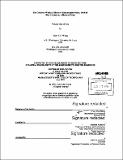| dc.contributor.advisor | Stanford Anderson. | en_US |
| dc.contributor.author | Wong, Yunn Chii, 1954- | en_US |
| dc.contributor.other | Massachusetts Institute of Technology. Dept. of Architecture. | en_US |
| dc.date.accessioned | 2005-08-22T18:56:37Z | |
| dc.date.available | 2005-08-22T18:56:37Z | |
| dc.date.copyright | 1999 | en_US |
| dc.date.issued | 1999 | en_US |
| dc.identifier.uri | http://hdl.handle.net/1721.1/9512 | |
| dc.description | Thesis (Ph.D.)--Massachusetts Institute of Technology, Dept. of Architecture, 1999. | en_US |
| dc.description | Includes bibliographical references (v. 2, p. 29-105). | en_US |
| dc.description.abstract | The thesis investigates the geodesic structure and dome phase in the corpus of Richard Buckminster Fuller's artifactual production and writings. It offers a history of the meteoric rise of the geodesic structure, its production, deployment, reception and subsequent marginalization. The geodesic work, as a pinnacle of Fuller's life work, form a multi-layered symbolic project with significance that extends beyond architecture. While the geodesic dome is an aspect of Fuller's many artifactual productions, it is studied here as a culmination of a set of ideas that Fuller developed and refined over a course of forty years, beginning with the 4D-Dymaxion House. These ideas represent a set of poignant observations and critique of design and design practices in particular, and of contemporary American culture in general. At a cursory level, Fuller's invention of the geodesic dome in the late forties appears to be a historical aberration, given the traditional, deeply symbolic significance of the dome and the fairly entrenched modem aesthetic sensibility based on planes and asymmetry. Yet, over a period of twenty years, the geodesic invention reinvigorated a traditional archetypal form besides charging up new interests in all types of space-frame structures. The invention of the geodesic structure invention enjoyed professional attention and rallied public enthusiasm. However, with its swan-song at the Montreal Expo '67, it was quickly eclipsed and marginalized. The thesis shows that Fuller's geodesic work is an attempt to create a seamless continuity between nature and society, following on the heels of his first attempt (in the 4D-Dymaxion House phase) to create a similar continuity between society and industry and between production and consumption. To understand anyone of these aspects, one must posit the invention in the context of its inventor and the relationship of the desires he brought to bear on American society and culture in his time. | en_US |
| dc.description.statementofresponsibility | by Yunn Chii Wong. | en_US |
| dc.format.extent | 2 v. ([973] p.) | en_US |
| dc.format.extent | 194184328 bytes | |
| dc.format.extent | 194184087 bytes | |
| dc.format.mimetype | application/pdf | |
| dc.format.mimetype | application/pdf | |
| dc.language.iso | eng | en_US |
| dc.publisher | Massachusetts Institute of Technology | en_US |
| dc.rights | M.I.T. theses are protected by copyright. They may be viewed from this source for any purpose, but reproduction or distribution in any format is prohibited without written permission. See provided URL for inquiries about permission. | en_US |
| dc.rights.uri | http://dspace.mit.edu/handle/1721.1/7582 | |
| dc.subject | Architecture. | en_US |
| dc.subject | Fuller, R. Buckminster (Richard Buckminster), 1895-1983. | en_US |
| dc.title | The geodesic works of Richard Buckminster Fuller, 1948-68 : (the universe as a home of man) | en_US |
| dc.type | Thesis | en_US |
| dc.description.degree | Ph.D. | en_US |
| dc.contributor.department | Massachusetts Institute of Technology. Department of Architecture | |
| dc.identifier.oclc | 43782643 | en_US |

